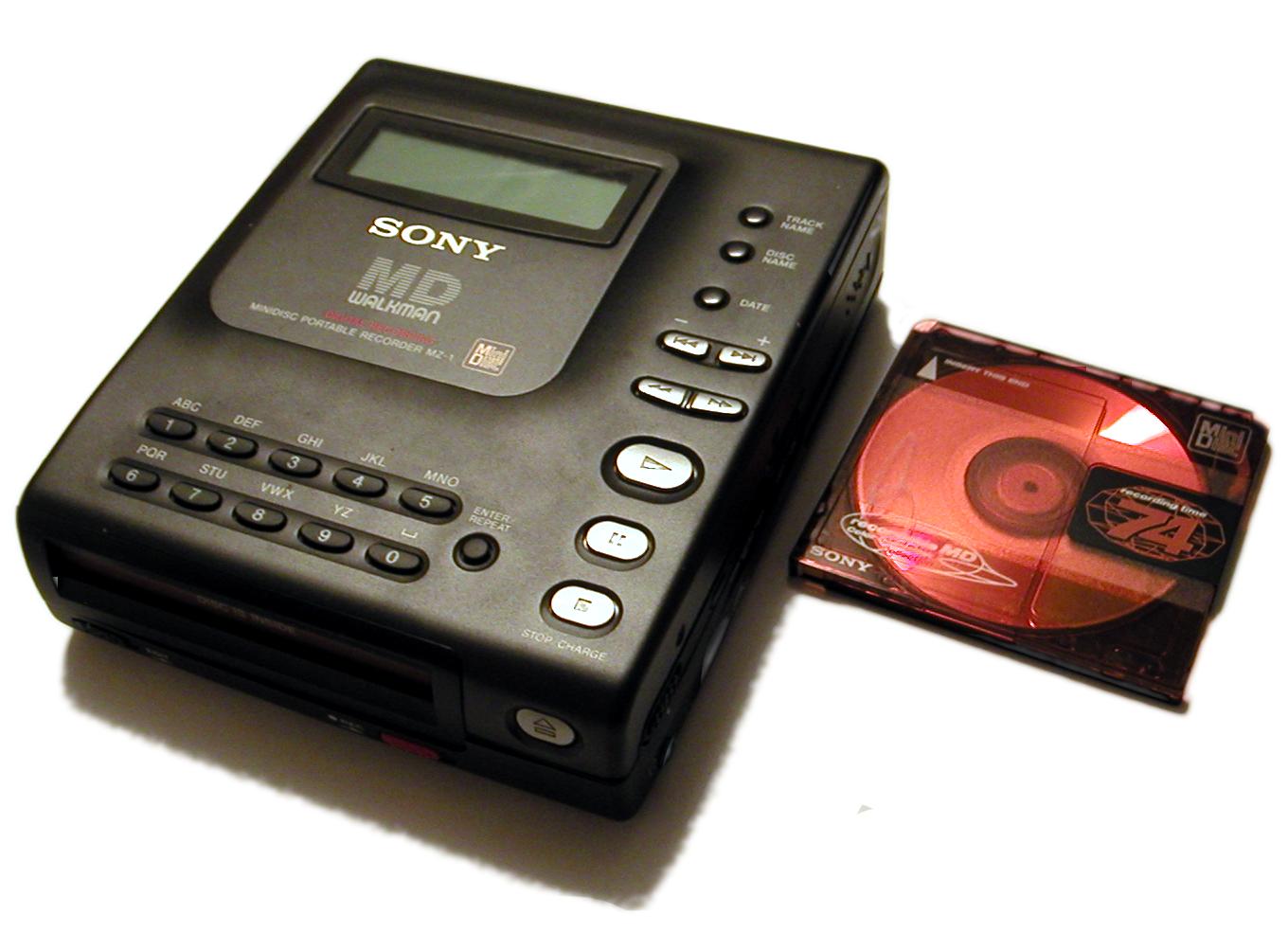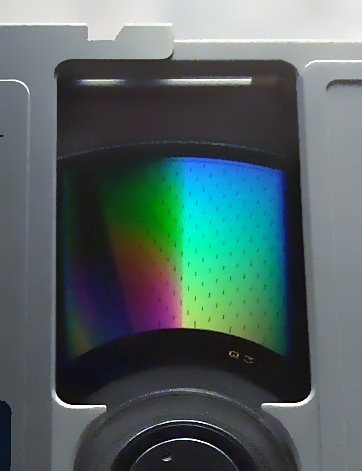|
Minidisc
MiniDisc (MD) is an erasable magneto-optical disc-based data storage format offering a capacity of 60, 74, and later, 80 minutes of digitized audio. Sony announced the MiniDisc in September 1992 and released it in November of that year for sale in Japan and in December in Europe, North America, and other countries. The music format was based on ATRAC audio data compression, Sony's own proprietary compression code. Its successor, Hi-MD, would later introduce the option of linear PCM digital recording to meet audio quality comparable to that of a compact disc. MiniDiscs were very popular in Japan and found moderate success in Europe; although it was designed to be the successor of the cassette tape, it did not manage to mass replace it globally. By March 2011 Sony had sold 22 million MD players. Sony has ceased development of MD devices, with the last of the players sold by March 2013. Market history In 1983, just a year after the introduction of the Compact Disc, ... [...More Info...] [...Related Items...] OR: [Wikipedia] [Google] [Baidu] |
Adaptive Transform Acoustic Coding
Adaptive Transform Acoustic Coding (ATRAC) is a family of proprietary audio compression algorithms developed by Sony. MiniDisc was the first commercial product to incorporate ATRAC in 1992. ATRAC allowed a relatively small disc like MiniDisc to have the same running time as CD while storing audio information with minimal loss in perceptible quality. Improvements to the codec in the form of ATRAC3, ATRAC3plus, and ATRAC Advanced Lossless followed in 1999, 2002, and 2006 respectively. Files in ATRAC3 format originally have the extension, however in most cases the files would be stored in an OpenMG Audio container using the extension . Initially files that were encrypted with OpenMG had the extension, before it was replaced by starting in SonicStage v2.1. Encryption is no longer compulsory as of v3.2. Other MiniDisc manufacturers such as Sharp and Panasonic also implemented their own versions of the ATRAC codec. History ATRAC was developed for Sony's MiniDisc format. ATRAC w ... [...More Info...] [...Related Items...] OR: [Wikipedia] [Google] [Baidu] |
Magneto-optical Drive
A magneto-optical drive is a kind of optical disc drive capable of writing and rewriting data upon a magneto-optical disc. Both 130 mm (5.25 in) and 90 mm (3.5 in) form factors exist. In 1983, just a year after the introduction of the Compact Disc, Kees Schouhamer Immink and Joseph Braat presented the first experiments with erasable magneto-optical Compact Discs during the 73rd AES Convention in Eindhoven. The technology was introduced commercially in 1985. Although optical, they normally appear as hard disk drives to an operating system and can be formatted with any file system. Magneto-optical drives were common in some countries, such as Japan, but have fallen into disuse. Overview Early drives are 130 mm and have the size of full-height 130 mm hard-drives (like in the IBM PC XT). 130 mm media looks similar to a CD-ROM enclosed in an old-style caddy, while 90 mm media is about the size of a regular 3-inch floppy disk, but twice the ... [...More Info...] [...Related Items...] OR: [Wikipedia] [Google] [Baidu] |
Compact Cassette
The Compact Cassette or Musicassette (MC), also commonly called the tape cassette, cassette tape, audio cassette, or simply tape or cassette, is an analog magnetic tape recording format for audio recording and playback. Invented by Lou Ottens and his team at the Dutch company Philips in 1963, Compact Cassettes come in two forms, either already containing content as a prerecorded cassette (''Musicassette''), or as a fully recordable "blank" cassette. Both forms have two sides and are reversible by the user. Although other tape cassette formats have also existed - for example the Microcassette - the generic term ''cassette tape'' is normally always used to refer to the Compact Cassette because of its ubiquity. Its uses have ranged from portable audio to home recording to data storage for early microcomputers; the Compact Cassette technology was originally designed for dictation machines, but improvements in fidelity led to it supplanting the stereo 8-track cartridge and ... [...More Info...] [...Related Items...] OR: [Wikipedia] [Google] [Baidu] |
Cassette Tape
The Compact Cassette or Musicassette (MC), also commonly called the tape cassette, cassette tape, audio cassette, or simply tape or cassette, is an analog audio, analog magnetic tape recording format for Sound recording and reproduction, audio recording and playback. Invented by Lou Ottens and his team at the Netherlands, Dutch company Philips in 1963, Compact Cassettes come in two forms, either already containing content as a prerecorded cassette (''Musicassette''), or as a fully recordable "blank" cassette. Both forms have two sides and are reversible by the user. Although List of magnetic tape cartridges and cassettes, other tape cassette formats have also existed - for example the Microcassette - the generic term ''cassette tape'' is normally always used to refer to the Compact Cassette because of its ubiquity. Its uses have ranged from Personal stereo, portable audio to home recording to data storage for early microcomputers; the Compact Cassette technology was originally ... [...More Info...] [...Related Items...] OR: [Wikipedia] [Google] [Baidu] |
Sony
, commonly stylized as SONY, is a Japanese multinational conglomerate corporation headquartered in Minato, Tokyo, Japan. As a major technology company, it operates as one of the world's largest manufacturers of consumer and professional electronic products, the largest video game console company and the largest video game publisher. Through Sony Entertainment Inc, it is one of the largest music companies (largest music publisher and second largest record label) and the third largest film studio, making it one of the most comprehensive media companies. It is the largest technology and media conglomerate in Japan. It is also recognized as the most cash-rich Japanese company, with net cash reserves of ¥2 trillion. Sony, with its 55 percent market share in the image sensor market, is the largest manufacturer of image sensors, the second largest camera manufacturer, and is among the semiconductor sales leaders. It is the world's largest player in the premium TV mark ... [...More Info...] [...Related Items...] OR: [Wikipedia] [Google] [Baidu] |
Digital Compact Cassette
The Digital Compact Cassette (DCC) is a magnetic tape sound recording format introduced by Philips and Matsushita Electric in late and marketed as the successor to the standard analog Compact Cassette. It was also a direct competitor to Sony's MiniDisc (MD), but neither format toppled the then-ubiquitous analog cassette despite their technical superiority, and DCC was discontinued in . Another competing format, the Digital Audio Tape (DAT), had by also failed to sell in large quantities to consumers, although it was popular as a professional digital audio storage format. The DCC form factor is similar to the analog compact cassette (CC), and DCC recorders and players can play back either type: analog as well as DCC. This backward compatibility was intended to allow users to adopt digital recording without rendering their existing tape collections obsolete, but because DCC recorders couldn't record (only play back) analog cassettes, it effectively forced consumers to either r ... [...More Info...] [...Related Items...] OR: [Wikipedia] [Google] [Baidu] |
MD Data
MD Data is a magneto-optical medium succeeding MiniDisc. Sony wanted it to replace floppy disks, but instead came the Zip drive, CD writers, and memory sticks and cards. Overview The technology has 140 MB of data storage, but it is slow and expensive. It is in products such as a still camera, a document scanner, and in late 1990s 4- and 8-track multitrack recording decks. Meant as a step up from the popular 4-track cassette-based studios, these recorders enjoyed a brief prominence before they were replaced by relatively affordable and far more flexible direct-to-hard drive recording on Windows and Macintosh based computers. The format lacks an affordable computer drive. Some examples of products that used the format are a few multitrack "portastudio"-style audio recorders such as Sony's MDM-X4 and Tascam's 564. MD Data2 In 1997, Sony introduced the MD Data2 format at 650 MB. The only product that used the format was Sony's DCM-M1 camcorder (capable of still images and MPE ... [...More Info...] [...Related Items...] OR: [Wikipedia] [Google] [Baidu] |
Sony MZ-1 And A Disc 20040221
, commonly stylized as SONY, is a Japanese multinational conglomerate corporation headquartered in Minato, Tokyo, Japan. As a major technology company, it operates as one of the world's largest manufacturers of consumer and professional electronic products, the largest video game console company and the largest video game publisher. Through Sony Entertainment Inc, it is one of the largest music companies (largest music publisher and second largest record label) and the third largest film studio, making it one of the most comprehensive media companies. It is the largest technology and media conglomerate in Japan. It is also recognized as the most cash-rich Japanese company, with net cash reserves of ¥2 trillion. Sony, with its 55 percent market share in the image sensor market, is the largest manufacturer of image sensors, the second largest camera manufacturer, and is among the semiconductor sales leaders. It is the world's largest player in the premium TV market for ... [...More Info...] [...Related Items...] OR: [Wikipedia] [Google] [Baidu] |
Panasonic Corporation
formerly between 1935 and 2008 and the first incarnation of between 2008 and 2022, is a major Japanese multinational conglomerate corporation, headquartered in Kadoma, Osaka. It was founded by Kōnosuke Matsushita in 1918 as a lightbulb socket manufacturer. In addition to consumer electronics, of which it was the world's largest maker in the late 20th century, Panasonic offers a wide range of products and services, including rechargeable batteries, automotive and avionic systems, industrial systems, as well as home renovation and construction. Panasonic has a primary listing on the Tokyo Stock Exchange and is a constituent of the Nikkei 225 and TOPIX 100 indices. It has a secondary listing on the Nagoya Stock Exchange. Corporate name From 1935 to October 1, 2008, the company's corporate name was "Matsushita Electric Industrial Co." (MEI). On January 10, 2008, the company announced that it would change its name to "Panasonic Corporation", in effect on October 1, 20 ... [...More Info...] [...Related Items...] OR: [Wikipedia] [Google] [Baidu] |
Videotape Format War
Videotape is magnetic tape used for storing video and usually sound in addition. Information stored can be in the form of either an analog or digital signal. Videotape is used in both video tape recorders (VTRs) and, more commonly, videocassette recorders (VCRs) and camcorders. Videotapes have also been used for storing scientific or medical data, such as the data produced by an electrocardiogram. Because video signals have a very high bandwidth, and stationary heads would require extremely high tape speeds, in most cases, a helical-scan video head rotates against the moving tape to record the data in two dimensions. Tape is a linear method of storing information and thus imposes delays to access a portion of the tape that is not already against the heads. The early 2000s saw the introduction and rise to prominence of high-quality random-access video recording media such as hard disks and flash memory. Since then, videotape has been increasingly relegated to archival and ... [...More Info...] [...Related Items...] OR: [Wikipedia] [Google] [Baidu] |






.jpg)
.jpg)